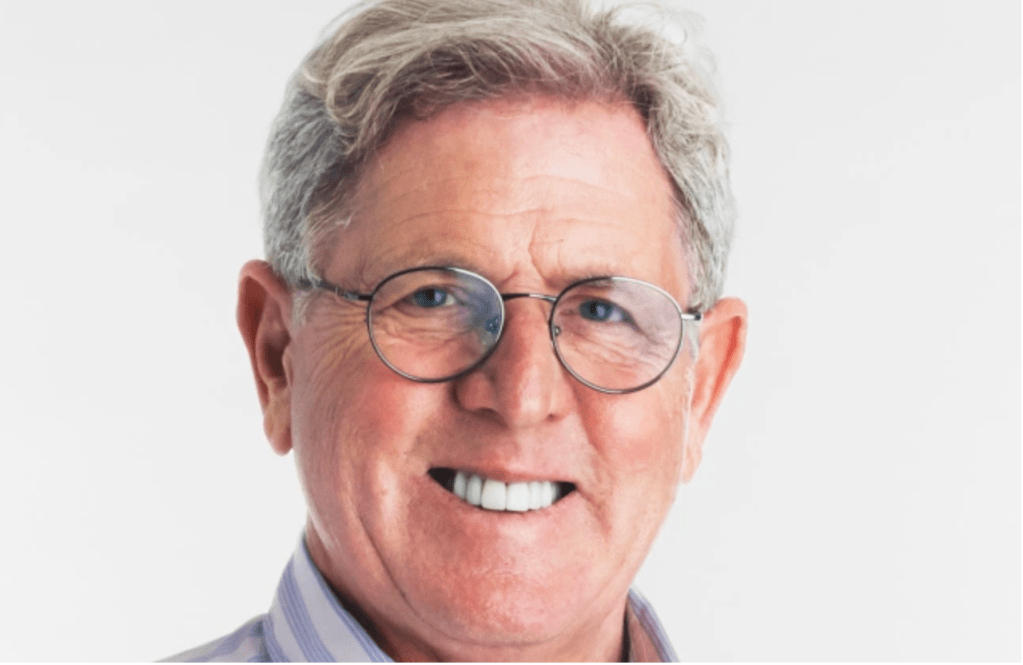The executive chairman of the board and chief executive officer of American Eagle Outfitters discusses fashion amid the era of COVID-19, the future of retail and what he’s learned in 50-plus years as a merchant.

By Kellie Ell | Link to article
Jay Schottenstein has been able to achieve a rare feat in the era of COVID-19.
The executive chairman and chief executive officer of American Eagle Outfitters Inc. — which includes the American Eagle, Aerie, Todd Snyder and Unsubscribed brands — has led the company through one of the most turbulent times in recent history and secured its place in the post-pandemic fashion world even as competitors close up shop or file for bankruptcy protection.
That’s thanks in part to the strong customer following for Aerie. The innerwear, swimwear and loungewear brand, which recently surpassed $1 billion in revenues, seems well suited to the times, with its work-from-home fashion and comfortable attire. It was also the first intimates brand to celebrate body diversity.
Schottenstein had the foresight to recognize this, long before it was fashionable. The seasoned retailer has demonstrated the ability to see opportunity in times of crisis. In the last year, in the middle of the global health crisis, American Eagle Outfitters launched two brands: The slow retail concept called Unsubscribed and the Aerie activewear subbrand Offline. The company was also quick to adjust its distribution methods while the U.S. was in lockdown, using regional distribution centers and pulling inventory out of stores to fulfill e-commerce orders, all of which dramatically cut costs.
But while other retailers continue to permanently shutter brick-and-mortar locations, Schottenstein believes in the value of physical retail. American Eagle Outfitters is planning to add to its store fleet in the next few years with more Aerie, Offline, Todd Snyder and Unsubscribed locations.
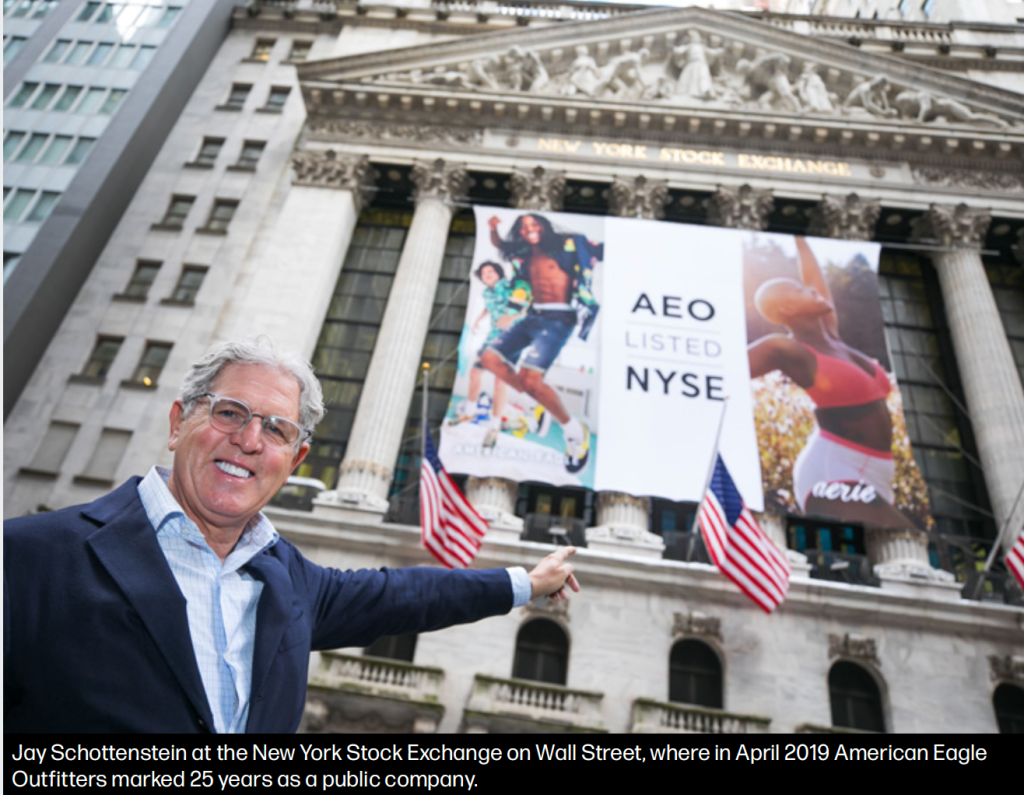
Investors seem pleased with American Eagle Outfitters’ momentum, too. The stock is up more than 70 percent, year-over-year.
Now the retailer is embarking on its next leg of expansion, with Schottenstein at the helm. At last month’s Investor Day, the company laid out new growth goals, including hitting $5.5 billion in total group revenues by 2023 ($2 billion at Aerie alone), $550 million in operating income and returning the American Eagle brand to profit growth over the next three years.
Meanwhile, the U.S. is ushering in a new era with President Joe Biden in office and continues to navigate its way through the pandemic. The usually quiet Schottenstein sat down with WWD last month for an exclusive interview to discuss his strategies for growth, the state of retail, the future of the mall in a digital-first world and how the industry has changed in his 50-plus years as a merchant.
The following has been edited for clarity and condensed.
WWD: You’ve had a great year. What’s the secret to your success?
Jay Schottenstein: I think two things that really made us so successful were that we were really focused on developing the Aerie business, expanding the Aerie business and growing the Aerie business. And taking advantage of this market time with the casual and with everyone staying home. And also, refining American Eagle Outfitters at the same time, with American Eagle stores and really pushing the denim in a really strong manner.
WWD: With the inauguration [of President Joe Biden], and as a business owner, how do you gauge consumers’ preferences? Looking at politics through the eyes of a business owner, how do you know what to expect from customers in this political environment?
J.S.: I don’t think today is going to change anything in that way. I think the biggest change is getting this pandemic under control, getting the virus under control, seeing the numbers go down, not going up and really getting more people vaccinated. In America, the only thing that’s going to make a big difference is the vaccination; how fast can we get the country vaccinated in order to get the herd immunity?
WWD: So you’re not as concerned about political unrest as a business owner?
J.S.: I don’t think so. Look, what happened…at the Capitol [with the mob insurrection] is unacceptable. It’s not the way to make change in this country. American people have always been peaceful people. And I hope that will continue. We have to have good communication amongst the people. And, look, there have been different times [throughout history]. I grew up during the Vietnam time, with protests there. People were worried about what’s going to happen with the country. The country survived. And I feel the country will survive this [era], too.
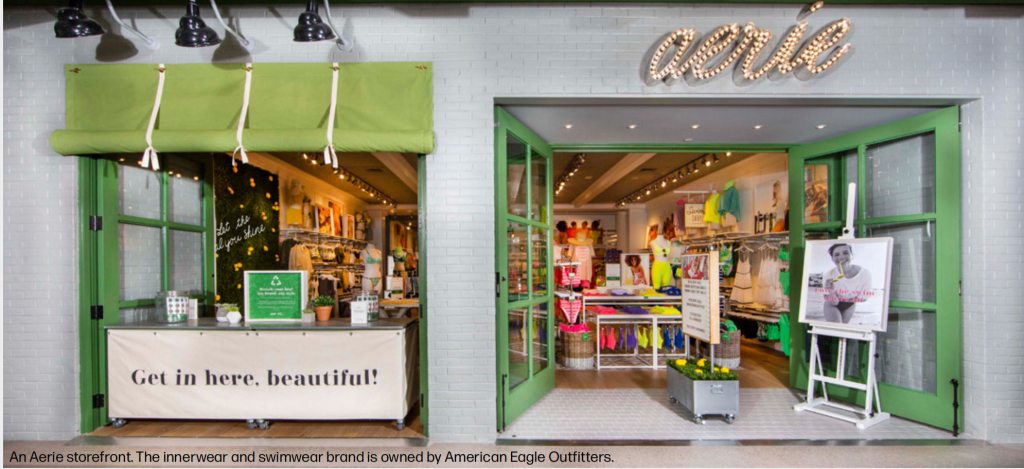
WWD: You’ve been in retail a really long time. What are your thoughts on specialty retail going forward? Do you think the future of retail is in malls? Online? Or somewhere in between?
J.S.: Brick-and-mortar is not going anywhere. It’ll still be here [in the future]. But today, it’s really the experiences that you have between the channels. You have to have a strong online business, a strong presence in your brick-and-mortar. But it all has to be one.
At American Eagle, we work very hard. We’ve made a lot of investments into our digital ability and also at our store level. We have the ability to do curbside pickup. You can order in the store and pick it up in the store. Or we’ll bring it to your car. At the same time, if you buy online, we work very hard to make sure the merchandise gets there in a timely fashion.
This past year, it’s been a very innovative year for us. We opened up these [regional] warehouses around the country, where we could get faster service and get quicker service to the stores and give quicker service to the customers at the same time, too. And where many retailers were experiencing difficulties this fall, because of what was happening between UPS and Federal Express, we were able to avoid those problems, because we had the ability — and not just to use Federal Express or UPS. We could use regional deliverers at the same time.

WWD: Do you think the future for retailers, all fashion companies, is that they’re going to need to have regional distribution centers?
J.S.: They’re going to have to. Look, today, in retail, you have to do it all. You have to make sure you have good logistics, you speak to the customers the right way, you can communicate through all the different channels and, at the same time, you can’t lose focus. You have to have good merchandise. You have to have good fashion. It has to be styled right. It has to be made right. It has to be good quality. And it has to have all the bells and whistles.
It’s not the old days; you open a store and put merchandise on the shelves. Today, in our business, what we’ve done is truly an amazing feat. We had to operate in certain states at 25 percent capacity. In California, you’re only allowed 25 percent capacity [in terms of] the amount of people allowed in stores, compared with how many people are normally allowed in stores. And the rest of the country is 50 percent capacity. So we’re running our stores on social distance protocols.
We’ve done that since the day we reopened back in May. We’re enforcing it ourselves. We believe it’s for the safety of our associates. It’s for the safety of the customer. We’re the only store that gives out masks, still, in the store. You have to wear masks to go into our store. And, at the same time, we’re running on 30 percent less inventory at the store level. Because we had to take fixtures out of the store and tables out of the store, in order to be able to give that social distance to the customer. So we’re not even working under our normal environment. This is not a case where we reopened our stores [under normal circumstances].
We reset all of our stores. And by resetting the stores, we had to put less merchandise in the stores. And not just a little bit less, a substantial amount less merchandise in the store. And in doing this, we’re still driving very good productivity. Our productivity is the best it’s ever been.
That’s the point right there. A lot of people don’t get that. The biggest thing with retail right now is that we’re driving sales with less inventory in the stores and we have to be the most productive that we’ve ever been. And a lot of people forget about that. They’re assuming that stores are open like normal, but they’re not normal. We have different hours than we’ve had in the past. It’s not a normal environment out there that we’re operating our retail stores on. But even despite that, they’re being very productive the way we’re doing it.
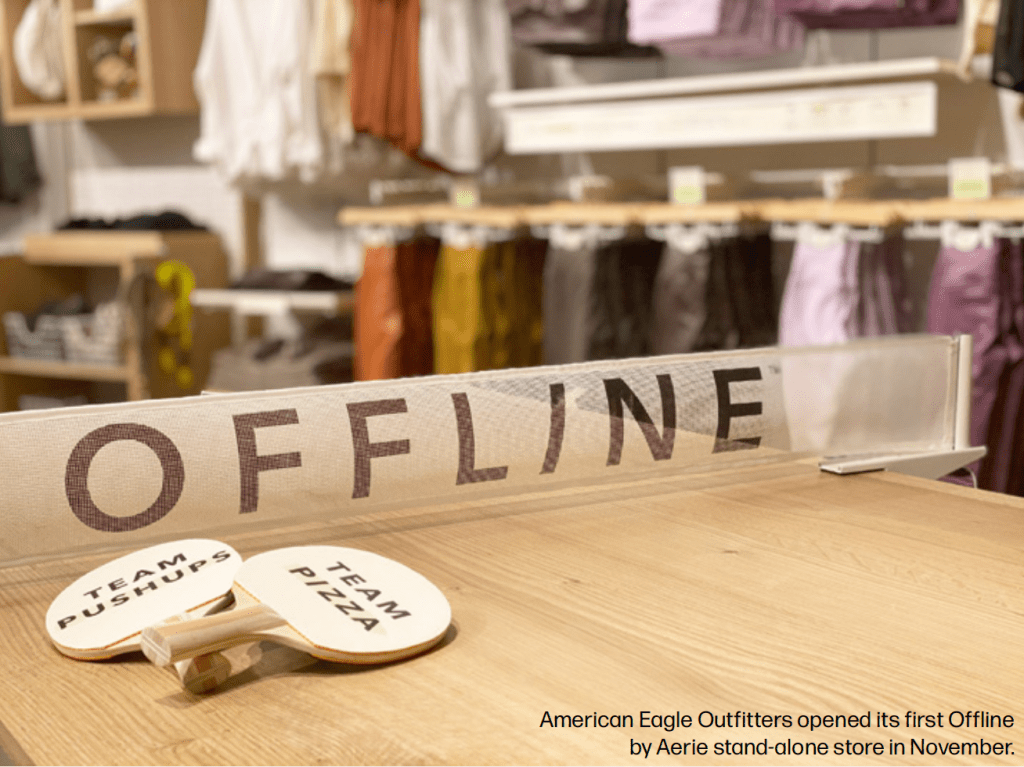
WWD: Bigger picture, in terms of investing in businesses and acquisitions, you’ve been in retail a long time — what’s your philosophy in investing in retail companies? How do you know what to look for?
J.S.: Every deal is a little different. It depends. Does it compliment our business? Not compliment our business? Is it a business that’s similar to ours that would fit into our system? What would be the backroom synergy? Does it make sense or not make sense? We just have to look at it as the deals pop up.
WWD: Who are your mentors? Who do you look up to? Or whom did you learn from in the retail industry? Was there one person or many people?
J.S.: I learned through different people over the years. In the beginning, my father, who was a great teacher. A gentleman who trained me since I was 16 years old. I learned through different facets.
I started in the furniture side of our business. And that’s been since I was 15 years old. I grew up from — really from my first 15 years in the business — I was really more on the furniture side. Then in my mid-30s I got involved in our department stores and that got me involved in the soft goods. At the same time, I was learning [from] our furniture stores, where we have more than 100-plus furniture stores. It’s called American Signature Furniture, which we’ve been operating since the late 1940s.
And then we have the department stores that I was in charge of. My father passed away in the early 1990s and then I became in charge of American Eagle, back in ‘91, ‘92. But back in those days, I had a major chain of department stores; I had a major chain of furniture stores. I ran two at the same time, as well as building shopping centers. And also running an asset recovery business. I probably ran more liquidation sales than anybody in the country.

WWD: In terms of international expansion, where do you see the American Eagle and Aerie brands going first? Are there certain countries that you’re targeting?
J.S.: We’re already international. But a small part [of our business] is international. We’re in Canada. We’ve been in Canada for many years. It’s really part of the North American business.
In the last couple of years we’ve been doing more major expansion into Mexico. It’s been becoming more of a major business. We have stores in South America that we’ve expanded into. We’re in the Middle East. We’re in Israel with 40-something stores. We’re in the rest of the Middle East: Dubai, Saudi Arabia, those countries over there.
We have stores in Hong Kong. We have stores in Korea, Japan and in China, too. And look, China is a major, major market and we only have a few stores for now. But there’s a big opportunity there. And now we just opened stores in India, too. And we still have Europe open to us. We still have Western Europe open and Eastern Europe open for us. So there’s tremendous opportunity in the next couple of years. The international will be over a billion-dollar business. And it’s very close to that right now.
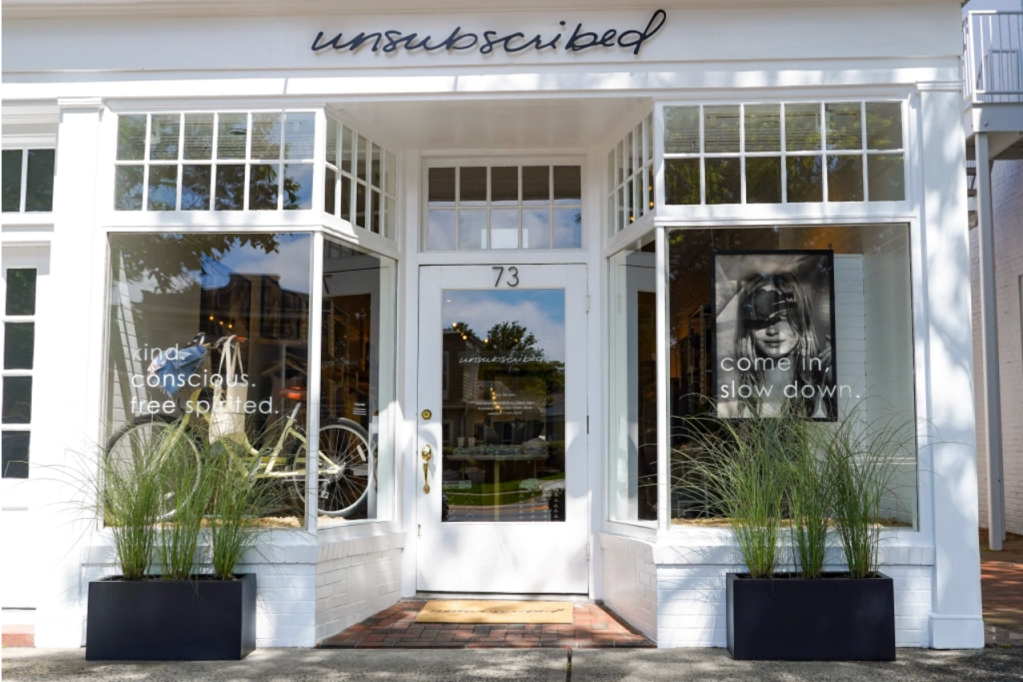
WWD: In terms of Unsubscribed and Todd Snyder, are there plans to open more stores in the next year? Or in the future?
J.S.: Yes, there is. Hopefully this year we can open close to five. Our goal this year, for Todd Snyder, is to get five stores open. And for Unsubscribed we’re looking for a few more stores. But our biggest expansion will be the Aerie stores and Offline.
WWD: What changes are you expecting to see in fashion and retail industries once the pandemic is over?
J.S.: You know what it comes down to, I think we still have, realistically, the next three months are not going to be pretty months in this country, until we get the people vaccinated. They’re predicting the next four weeks a tremendous amount of deaths in this country. It’s going to continue the way it’s been going.
I think when we get toward later spring, summertime, we’re going to start seeing the blue sky. It’s going to take people a little time to get comfortable going back to what they perceived as their previous normal, if they ever go back to that. I think it’s going to take a while for people to get comfortable flying commercial airlines again, traveling again and feeling comfortable. But they do feel comfortable wearing denim. They do feel comfortable wearing comfortable clothes. And from that standpoint that will continue. And then we’re probably a year away from when we could go into the Roaring Twenties.
We all have to pray these vaccines work. God forbid this thing doesn’t work, [then] we don’t know what we’re in for. But I’m optimistic. Right now, it looks very good.
WWD: In terms of three-year growth strategy, what are your top priorities?
J.S.: Our top priorities, very simple: the growth of Aerie, number one. Boom. We’re going to continue the growth of Aerie. And that’s with Offline. Our goal is to go from $1 billion in the next three years to $2 billion in three years. Grow that by $1 billion.
We see a big opportunity in American Eagle to reignite American Eagle’s growth and profit at the same time. We believe in American Eagle, we have a lot of opportunity. There are certain things we do very well at American Eagle. Our denim business, [for example]. When you look at our denim business, you see that between 15- and 25-year-olds we’re number one. And for women’s overall, we’re the number-one women’s brand in the country, in denim. That gives us great potential for our tops business to grow. We see major opportunity there, in American Eagle, that we’re very excited about.
The third thing is that we see that our digital transformation is the right way. We’ve been growing our digital business strong. And we see that opportunity to keep refining that and making us one of the most exciting sites to shop on.
WWD: Do you think there’s a chance you’ll launch more brands? Or acquire more brands in the next couple of years?
J.S.: Look, Offline, I think, could be a major, major brand. We see big opportunity there. And in the next three or four years, there will be other opportunities. But I don’t want to guess what those opportunities are.
I’m sure that there will be opportunities there. There may be a lot of subbrand opportunities for us. Look, I think Todd Snyder can be a very great brand, too. We see a great opportunity in Todd’s area there. So this year we want to get five stores going. And if everything goes well there, that could be a 50-, 60-store chain and be a very strong chain there, too.
And then Unsubscribed has a good possibility. And who knows what pops up, what chains pop up or something that pops up too in the next couple of years. But our main focus — we don’t want to lose our focus — we know we have a big opportunity with Aerie. We’ve got a big opportunity with American Eagle. And if we stay focused on those two, we’ll be very successful just with those two.
We don’t have to add other brands to make us successful. But if the right opportunity comes, that’s a different story. But right now we’ve got such a big opportunity with Aerie and American Eagle that if we stay focused there and we do our thing right and efficiencies and we develop our distribution ability to keep improving that, we will be the winner of the game.
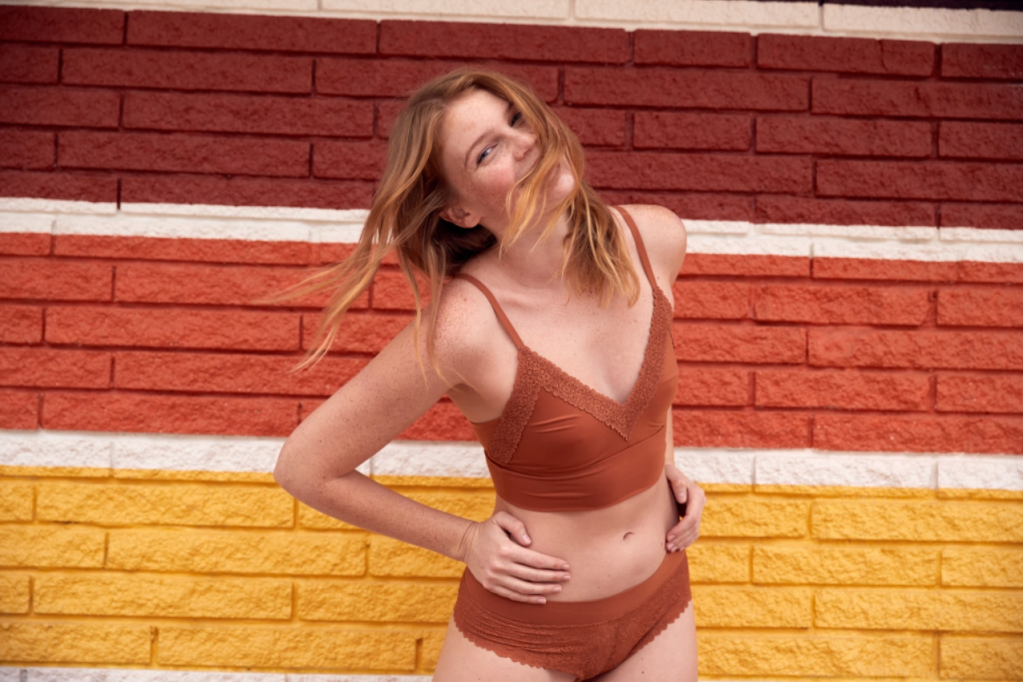
WWD: You guys have been such leaders in the body positivity movement at Aerie. That was years before anyone else saw it. How did you first see that opportunity? How did it first present itself to you?
J.S.: Jen [Foyle, AEO’s chief creative officer] and the team saw that opportunity there, saw that the woman customer wasn’t necessarily looking to be a fantasy. That people wanted to be themselves. They saw that the climate was changing. That parents and people wanted to feel good about their real selves, not some type of fantasy. And they were able to work with that concept to make people feel good about themselves and not be a fantasy.
WWD: Do you think there’s still space to evolve in the body-positivity movement?
J.S.: There’s a lot of space, big space.
WWD: There are so many copycats now; so many people trying to do what you’re doing. How do you stay ahead of the competition?
J.S.: That’s what we tell ourselves every day. That if we don’t keep developing exciting products, new, exciting categories, because [maybe] those other categories are bad — and that’s a big opportunity to keep developing the brand — then somebody else will catch us. So we have to stay ahead of them. A part of being a good merchant is challenging ourselves on a regular basis. Not just saying, “OK we’re here.” We keep evolving. It’s an evolving process. It doesn’t stop.
WWD: What is the biggest lesson(s) that you’ve learned this year throughout the pandemic? And how will you apply them in the future?
J.S.: I think the biggest lesson that we learned, despite everything, is agility. That when everything came shutting down back in March — and we had to close a thousand stores in two days, back in March, and we didn’t have anybody in our offices — we had distribution centers that we had to fight to keep open, because everyone was telling us to shut down. And we had to show that they were essential workers and how important it was to keep these distribution centers open. We learned that agility and to make things happen. And even despite not being on the site, but having the new technologies and learning how to work with these technologies, it gave us a lot of agility. And we can’t lose that agility and that flexibility.
